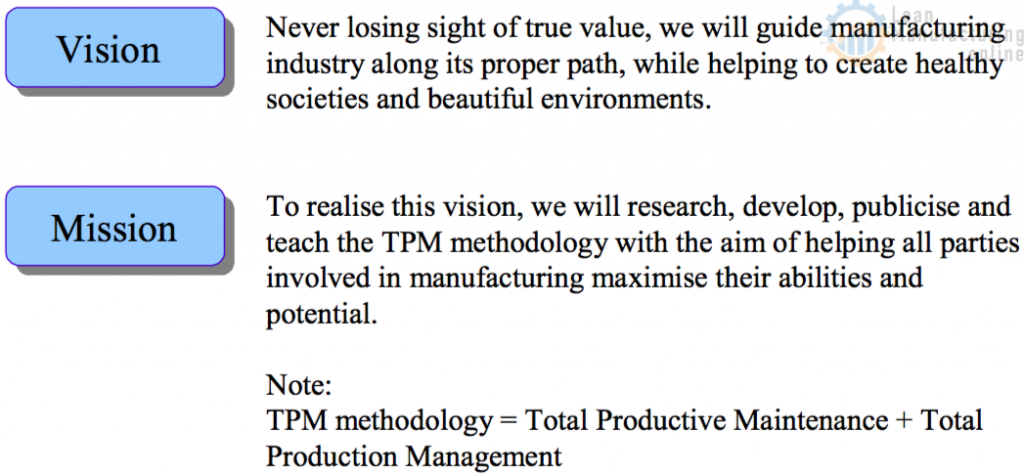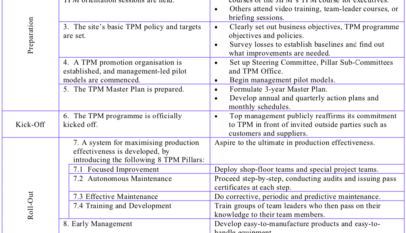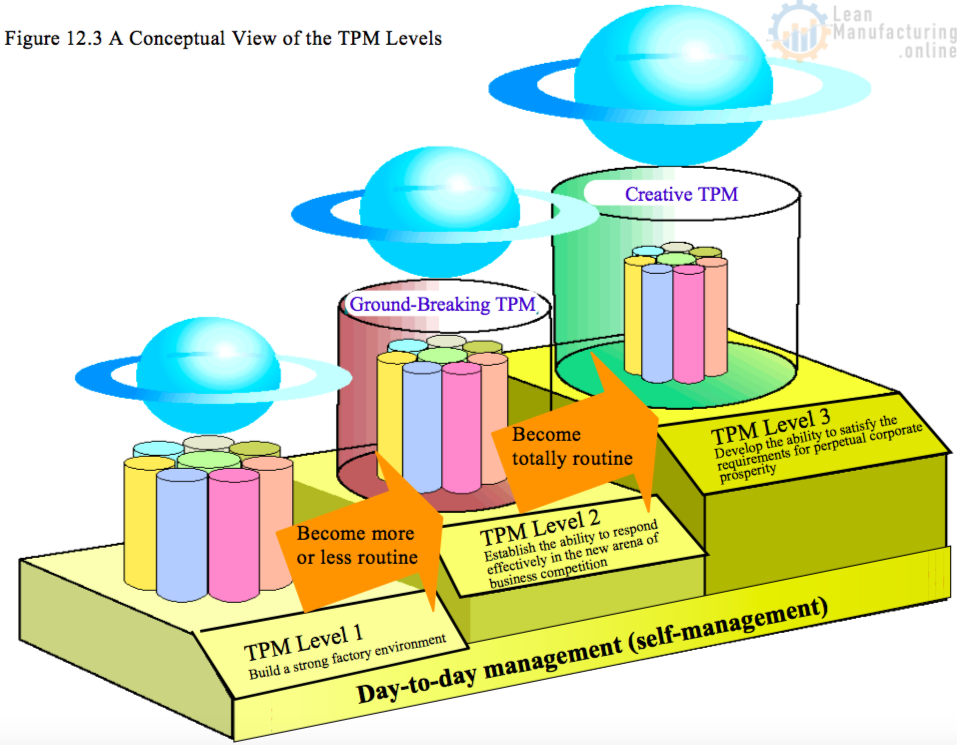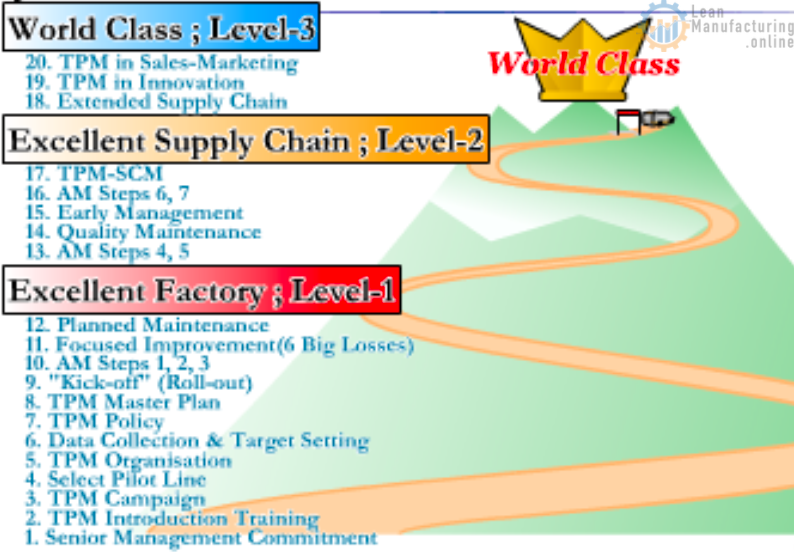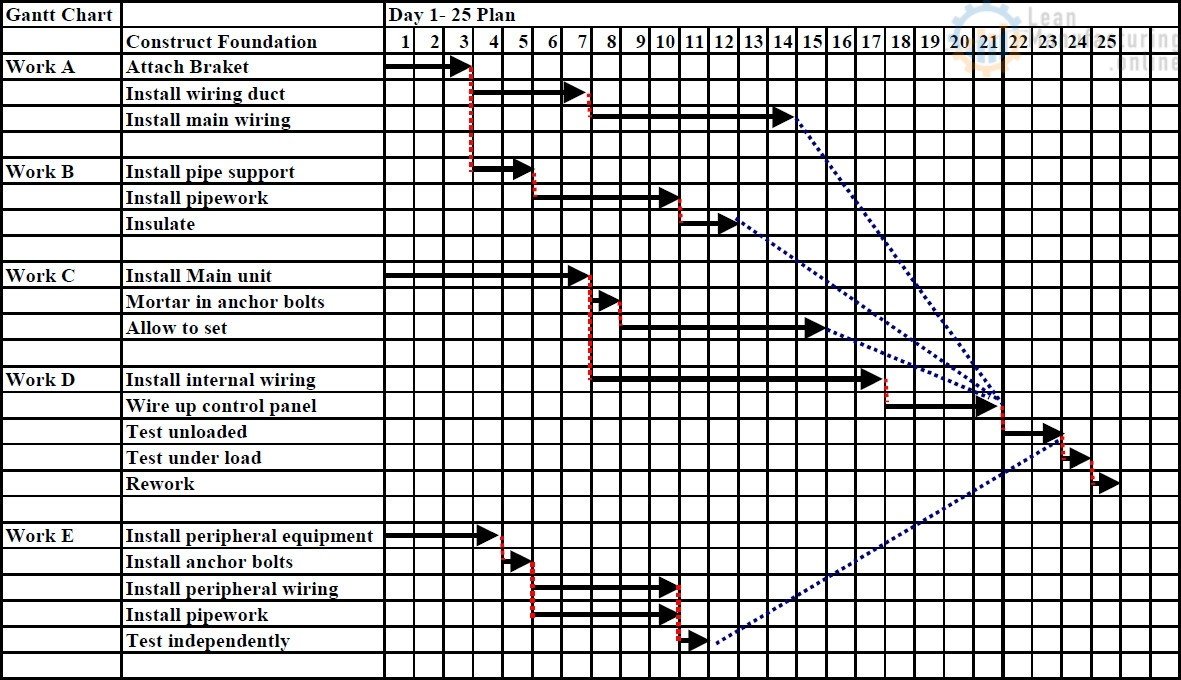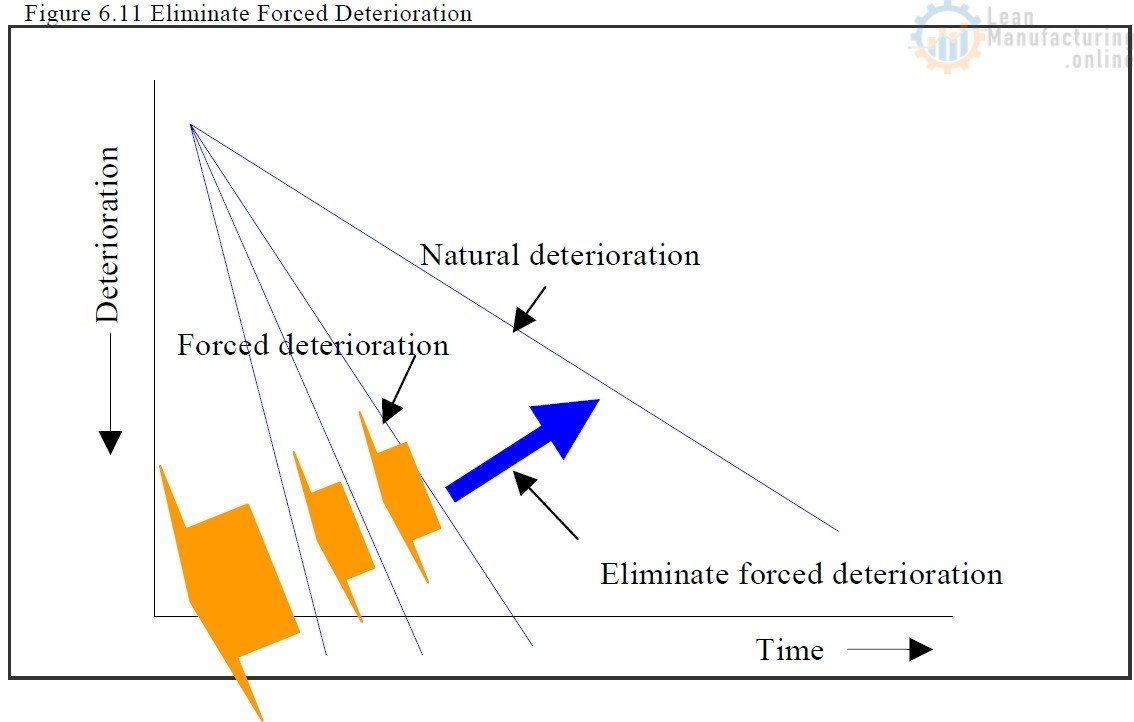4 TPM Level 3
4.1 The Concept of TPM Level 3 – Improving Cash Flow
As explained in the previous section, in TPM Level 2, we try to achieve the paradigm shift from ‘selling whatever we can make’ to ‘making only what we can sell’. The precondition for this is to strive to be as profitable as possible at a given sales volume (i.e. at a given level of utilisation). However, the sales of a particular product (and consequently the level of utilisation of the plant that produces it) usually decline steadily as the product ages. The management resources assigned to the product become a burden, constraining the product’s profitability. Another problem is the increasing uncertainty of demand. It is becoming more and more difficult to predict how much of what products will sell, making it easy to miss business opportunities and creating dead stock because of falling sales and utilisation rates.
In TPM Level 3, we continue to apply the thinking of TPM Level 2 while striving to establish the conditions necessary for our companies to continue to flourish in a business environment full of uncertainty. In addition to operating as profitably as possible with existing sales volumes, we try to build a profitable business framework that continually expands sales and always utilises the available resources as efficiently as possible. The aim is to be the top player in our industry in a broad range of indicators including new- product market share, cost competitiveness, quality, and resource conservation.
We also try to achieve a truly profitable business management structure by optimising not just our production processes but all of our business processes. We strive to maximise ROA (return on assets) and other indicators of resource utilisation efficiency by moving from raising our business management productivity to improving our company’s overall cash flow. This requires another paradigm shift, from developing and making only what is needed only when it is needed, to developing, making and supplying only what has been sold only when it has been sold. The key phrase here is ‘when it has been sold’; we need to think of productivity as being directly linked to our customers’ reactions. In other words, we need programmes that will give our companies the flexibility to respond instantly to market information. The four items listed in Figure 12.13 are of vital importance in this context:
Figure 12.13 The 4 Key Points of TPM Level 3
The target — improve cash flow
- Sustain the basic capabilities of the production floor.
- Establish QCD in R&D and in prototyping and pre-production.
- Strengthen and enhance activities for creating overall added value.
- Conduct environmental and resource conservation programmes.
4.2 The Scope of TPM Level 3
As Figure 12.14 shows, the scope of application of TPM at Level 3 is further extended to cover the entire supply chain, from order receipt right through to delivery.
Figure 12.14 The Scope of TPM Level 3

4.2.1 The concept and aims of TPM Level 3
Concept: A programme for generating profits by eliminating and preventing the constraints and losses that stand in the way of improving the company’s overall cash flow.
In TPM Level 3, we try to establish a profitable company wide business management structure by utilising our resources as efficiently as possible and developing the ability to satisfy the requirements for perpetual corporate prosperity (see Figure 12.13). In other words, as well as sustaining and upgrading the activities we started in TPM Levels 1 and 2, we try to become even more profitable by eliminating and preventing every kind of loss including even utilisation losses and losses due to selling at below cost.
In TPM Levels 1 and 2, our efforts are focused on becoming as profitable as possible at a given level of sales (i.e. at a given level of utilisation). But, as mentioned earlier, the level of sales of a product and the utilisation of the equipment that produces it usually decline as the product gets older. This decline in utilisation leads to overcapacity, and management resources such as equipment, personnel and land become underused and constitute the biggest constraint on profitability. Dealing with this issue is one of the principal aims of TPM at Level 3; for example, we try to achieve the highest share of demand in our industry by developing innovative new products through our R&D programmes and by actively approaching customers with imaginative sales proposals.
Being number one does not stop at market share; we should also strive to be top in a broad range of output indicators including number of days without an LTA (lost-time accident), resource conservation, equipment reliability, cost competitiveness, number of hours of unattended operation, and quality. At Level 3, companies are expected to achieve significant results in all of these areas.
We also try to achieve a truly profitable business management structure by optimising not just our production processes but our business processes in their entirety. We strive to achieve a truly profitable manufacturing business management structure that leads to the optimisation of our total business process (i.e. to improved total corporate cash flow) as judged from the standpoint of business management productivity rather than production productivity. This means that our programmes must develop to the point where they can help to raise the company’s business management productivity. They must evolve from activities that generate profits at the point of manufacture or the point where costs arise to activities that generate profits at the point of sale. They must also maximise ROA (return on assets) and other indicators of resource utilisation efficiency.
4.3 The Challenges of TPM Level 3
Figure 12.15 The Challenges of TPM Level 3

4.3.1 A summary of TPM Level 3
As already stated, the concept of TPM Level 3, the stage at which companies strive to achieve the Award for World-Class TPM Achievement, is to generate profits by eliminating and preventing the constraints and losses that stand in the way of improving the company’s overall cash flow. The aim of this is to develop the ability to satisfy the requirements for perpetual corporate prosperity, against the background of the ability to respond effectively in the new arena of business competition, which is reinforced during TPM Levels 1 and 2.
In Level 2, this means the ability to cope with the transition from an environment in which we can sell whatever we make to one in which we must make only what we can sell. In other words, we are trying to evolve our TPM programme into a truly profitable one by implementing a paradigm shift from improving the productivity of our production operation to improving the productivity of our entire business.
In Level 3, we continue along these lines while attempting to establish the conditions that will allow our company to remain permanently profitable by responding appropriately to future changes in the business environment. In TPM Levels 1 and 2, our efforts are focused on becoming as profitable as possible at a given level of sales (i.e. at a given level of utilisation). But, as already mentioned, all products have a natural life- cycle, and their sales inevitably decline. In TPM Level 3, we develop innovative new products that will boost our sales and utilisation rates, doing so rapidly and at the right time, with the aim of generating profits by expanding existing sales and creating new ones. By doing this, we believe we can put in place the conditions that will allow our companies to continue to prosper.
The level of uncertainty in markets will continue to rise as we move further into the 21st century. It will become impossible to predict how much of what product will sell. This uncertainty in demand will lead to declining sales and utilisation rates, lost business opportunities, increasing levels of dead stock, and lower cash flow efficiency. In times like these, the condition that companies must satisfy in order to remain profitable is to have the ability to develop, manufacture and supply only products that can be sold, when they can be sold, in the quantities in which they can be sold. They must also achieve the top position in their industry in all kinds of output indicators. This means that their programmes of activities must evolve from reforming their production processes to reforming their business processes. This is an important component of the challenge for the Award for World-Class TPM Achievement.
Another distinctive feature of TPM Level 3 is that, whereas in Level 1 (where we focus on reducing production cost) and in Level 2 (where we concentrate on reducing total product cost) we look at things at the point in time when costs arise and cash flows out of the business, in Level 3 we look at things at the point in time when revenue is received and cash flows into the business. By evolving our activities from those designed to generate profits at the point in time when products are made to those designed to generate profits at the point in time when products are sold, we aim to raise business productivity, boost cash flow efficiency and maximise indicators of resource utilisation efficiency such as ROA and turnover of total capital employed.
As far as business productivity is concerned, whereas in TPM Level 2 we focus on developing and making only what is needed only when it is needed, in TPM Level 3, the idea is to develop, make and supply only what is sold only when it is sold. In other words, we treat productivity as being linked to the actual demand from customers and the marketplace, taking the point of sale as our base point.
4.4 What Should be Achieved during TPM Level 3
Figure 12.16 summarises the things that a company needs to achieve during TPM Level 3.
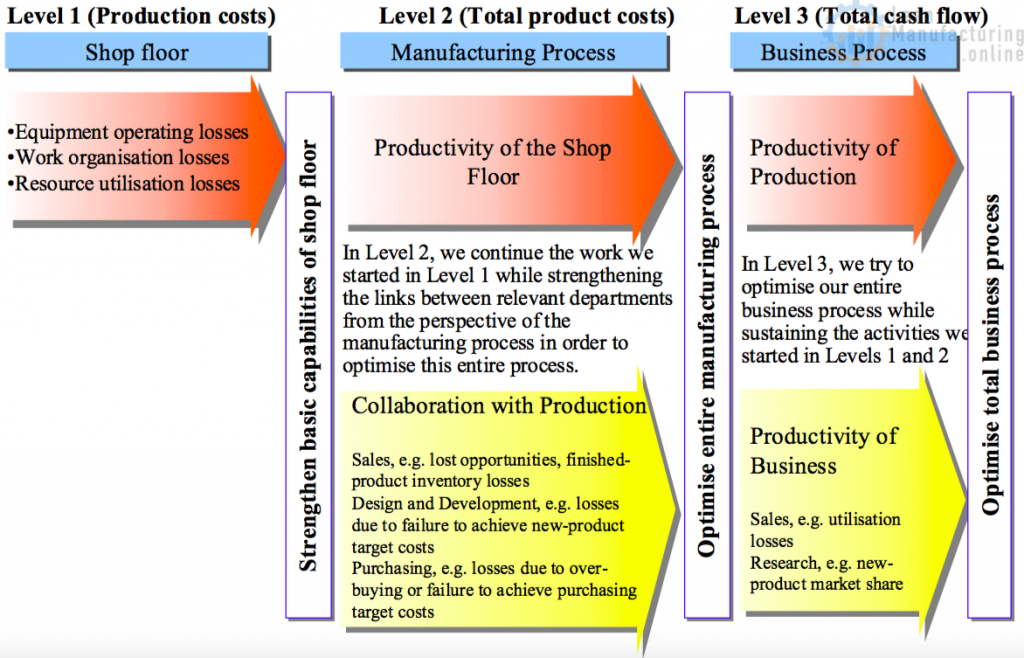
The activities needed at TPM Level 3 can be summarised in the following four key points:
- Sustain the basic capabilities of the production floor (make best practice routine).
- Establish QCD in R&D and in prototyping and pre-production.
- Strengthen and enhance activities for creating overall added value.
- Conduct environmental and resource conservation programmes.
Figure 12.17 Characteristics of Cash-Flow Accounting
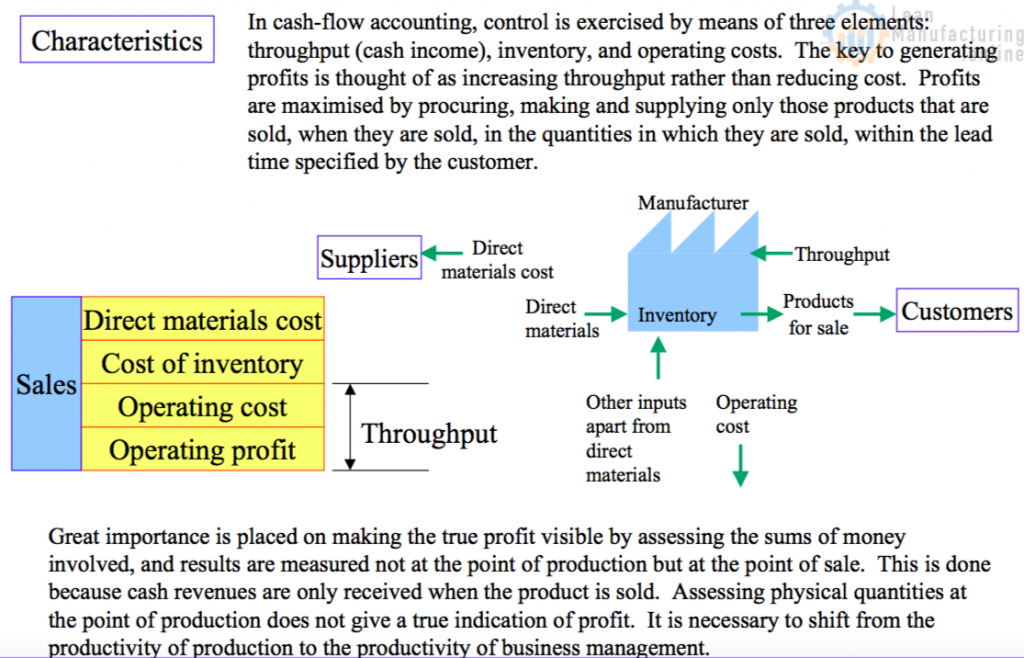
Figure 12.18 What is ‘Creative TPM’?
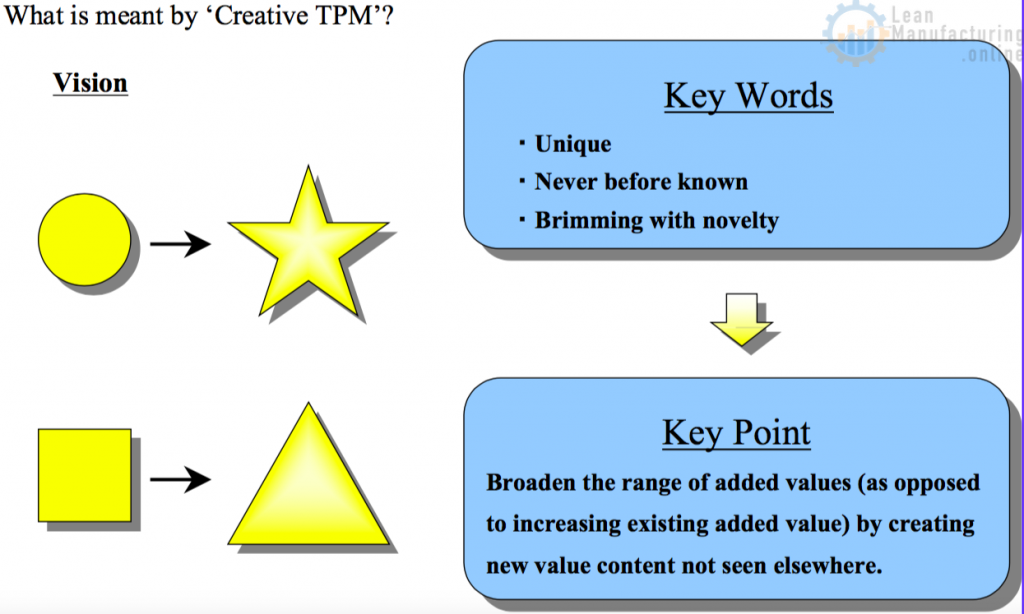
Creative activities are also part of the challenge for the Special Award for TPM Achievement (Level 2), in the form of focused improvements designed to increase added value. However, the activities at this level are biased towards increasing existing added value by doing even deeper kaizens on the sorts of topics already being addressed (this is the meaning of the term ‘ground-breaking’). They are the kinds of activities designed to increase the added-value content of existing products, make them more cheaply than any other company can, and satisfy production demands orders of magnitude more quickly.
In TPM Level 3, by contrast, being creative means becoming an industry leader and producing unique products of a type that have never existed before, as illustrated in Figure 12.18. This is what is meant by ‘Creative TPM’ at this level.
It is also possible to categorise the activities carried out at Level 2 as focusing on securing repeat sales from existing customers and markets, while those at Level 3 focus on developing new customers and markets. If a company can secure global support by developing new customers and markets quicker and with better timing than its competitors, it will naturally be able to achieve the top levels in its industry in a variety of output indicators. It will also be able to maximise the efficiency with which it utilises its resources, achieve the best possible cash flow efficiency, and establish the conditions necessary for its continued prosperity. In summary, while TPM Level 2 aims to generate higher profits in situations where products are already being sold, TPM Level 3 aims to generate additional profits by creating new situations in which products can be sold, and expanding these.
In other words, TPM Level 3 is targeted at creating and expanding cash inflow, thereby putting in place the conditions for the company’s continued prosperity. These are the challenges companies face as they go for the Award for World-Class TPM Achievement, and they will constitute the main thrust of their activities at this level.
Suggested Policies and Goals for Ground-Breaking and Creative TPM Programmes
TPM Policies and Goals (Ground-Breaking and Creative TPM Programmes)


TPM Benefits
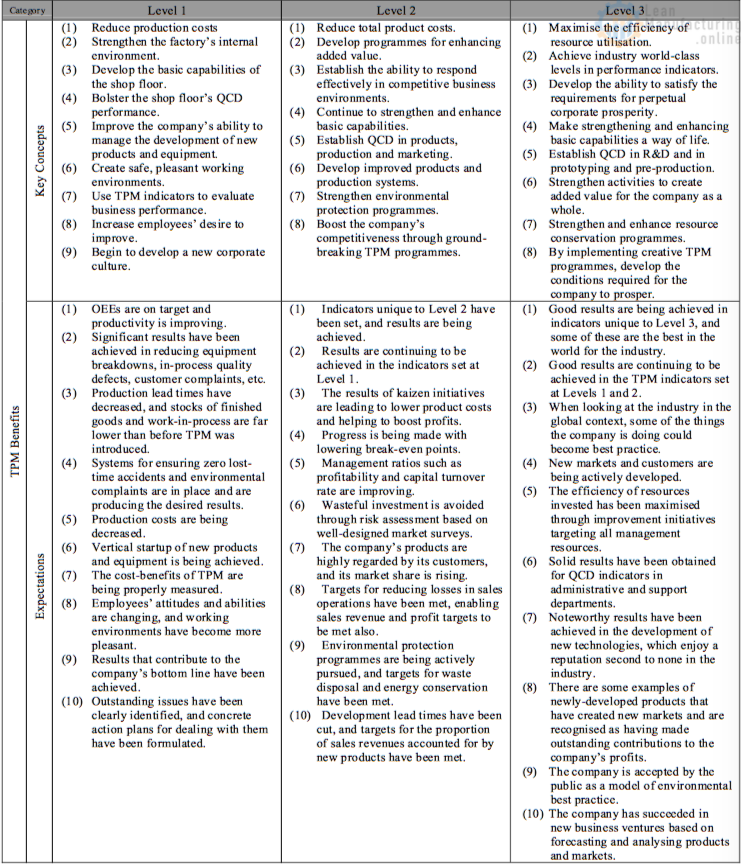
Focused Improvement
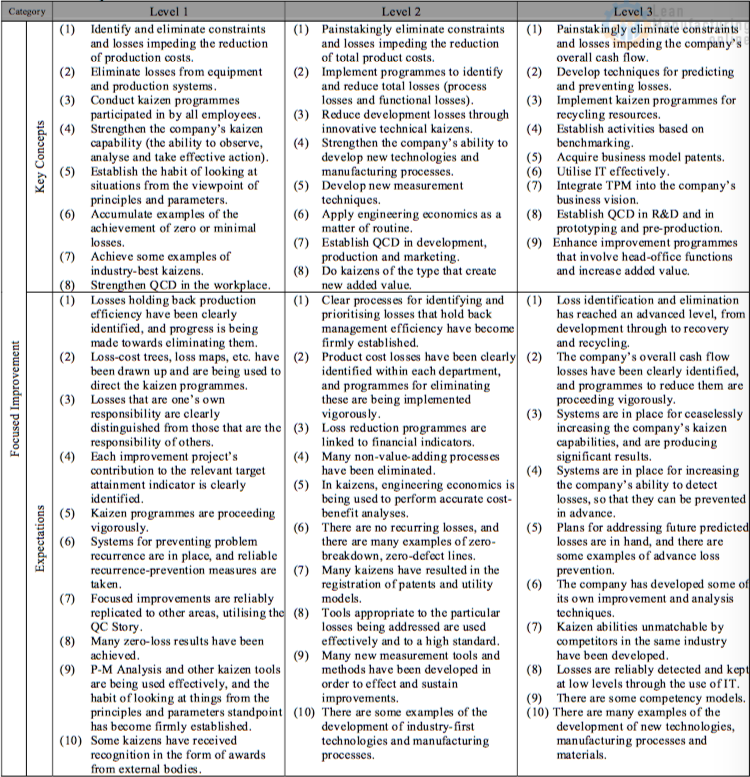
Autonomous Maintenance

Effective Maintenance
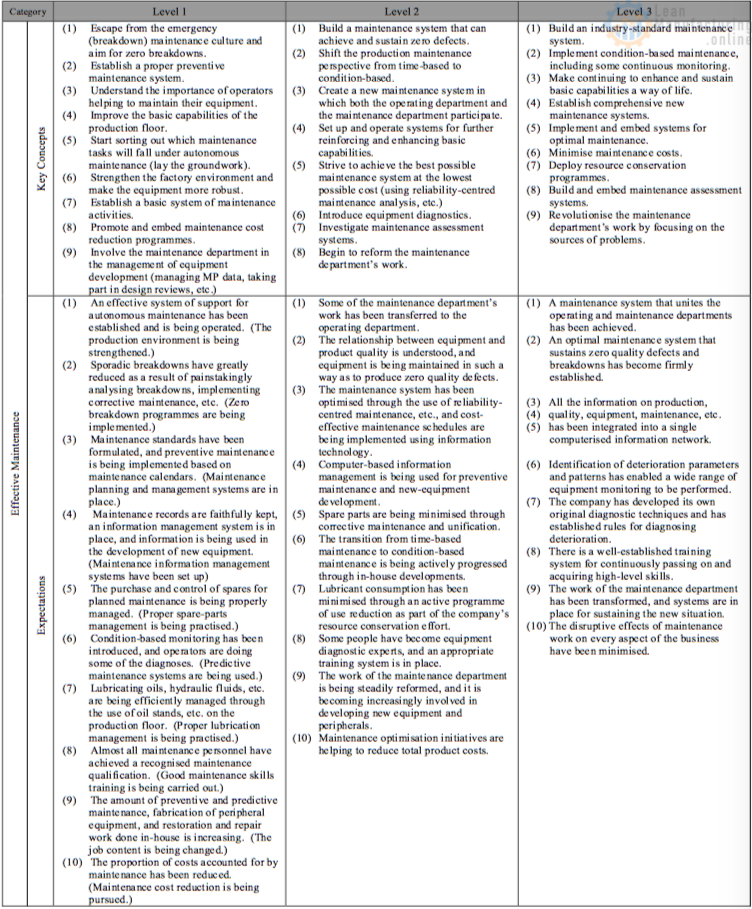
Early Management
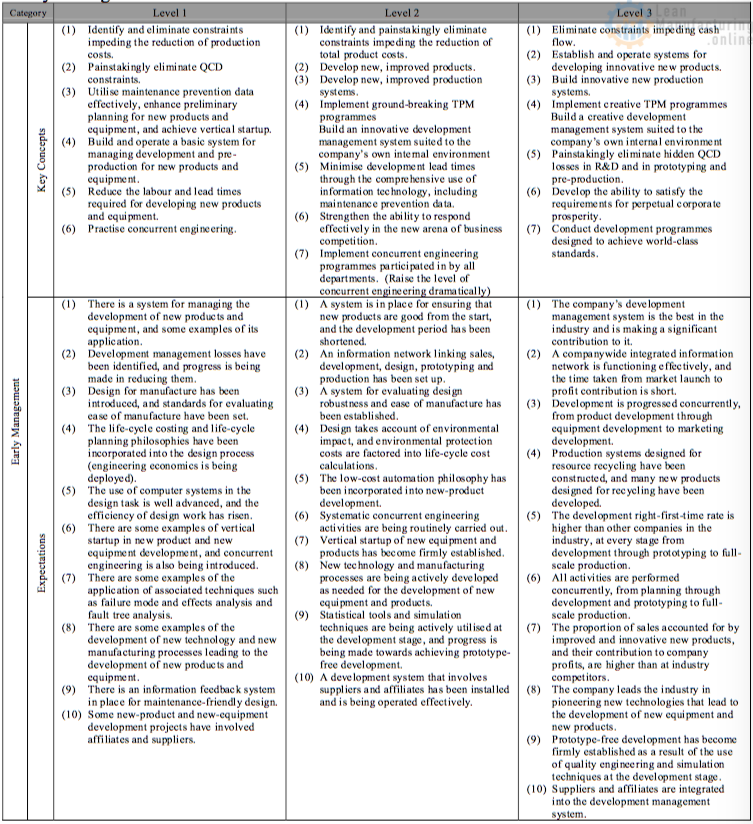
Quality Maintenance
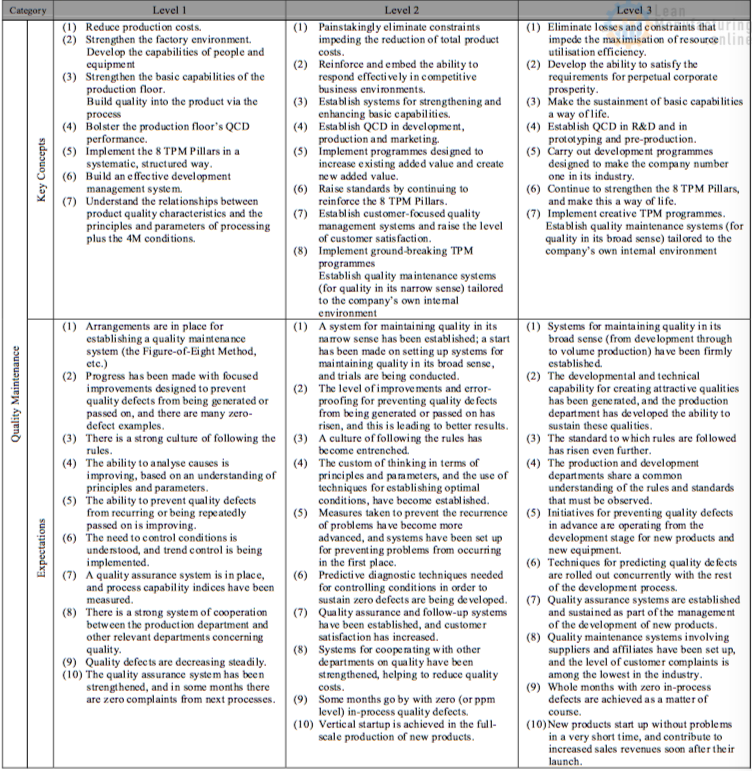
Training and Development
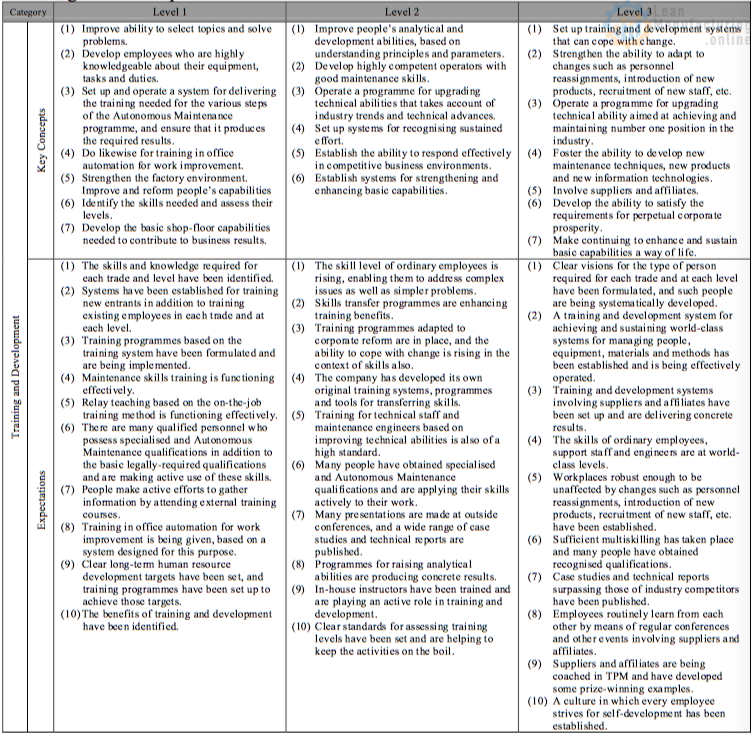
Administration and Support Departments
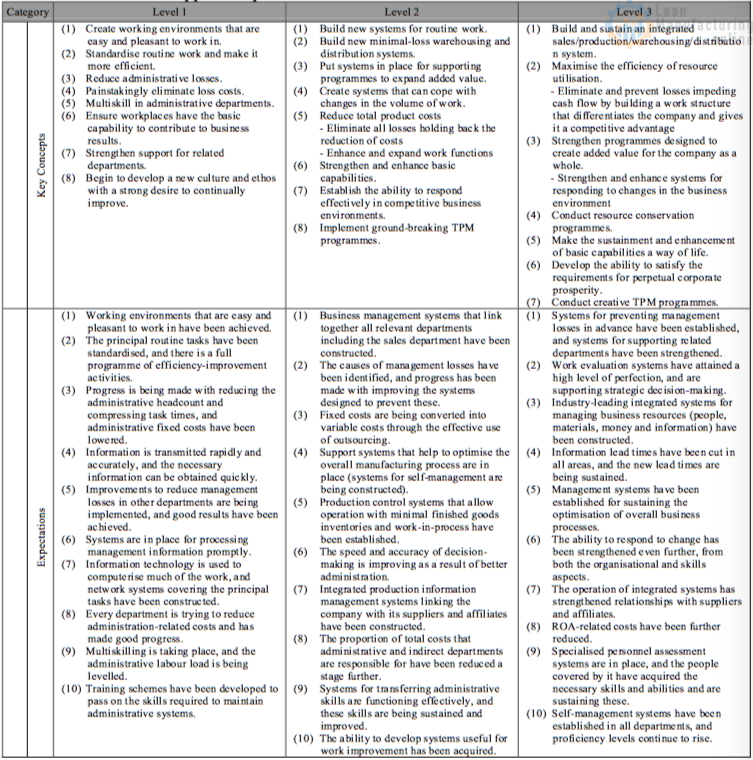
Safety, Health and Environment

5 TPM’s Vision and Mission
Figure 12.19 TPM’s Vision and Mission
